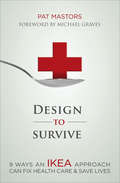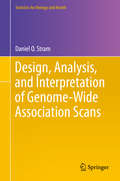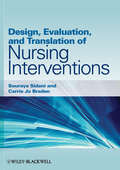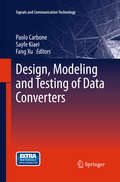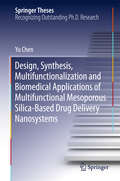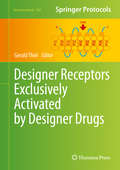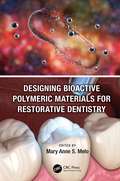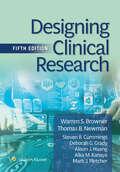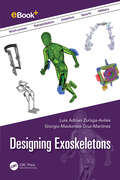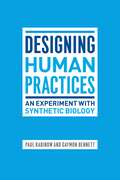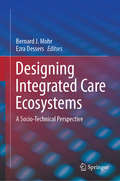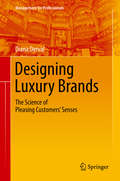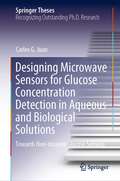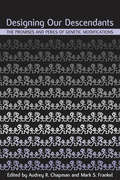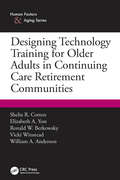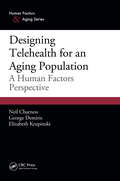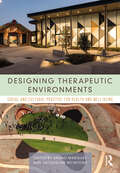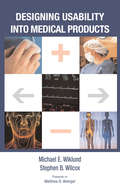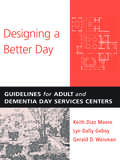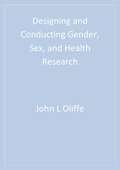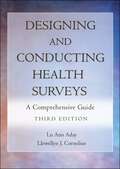- Table View
- List View
Design to Survive: 9 Ways an IKEA Approach Can Fix Health Care & Save Lives
by Pat Mastors&“Offers a foundation for both providers and consumers to find the balance, and move to a world from provider-centered care to patient-centered care.&” —Stefan Gravenstein, MD, MPH, Professor of Medicine, Case Western Reserve University The US spends the most in the world on health care and research, yet our outcomes are among the worst in industrialized nations. Hundreds of thousands die every year from medical harm. Imagine a world where health care took a page from the IKEA furniture company—where expenses were streamlined, quality was predictable, customers participated, and everyone shared in the cost savings. Through colorful analogies, stories from families and top doctors, and the author&’s quest to find out what happened to her own father, Design to Survive serves up key strategies for patients, families and providers, with the conviction that we can do better. &“Had me hooked from the first page . . . chock-full of stories, vital information, checklists, links, and resources . . . a must own for both clinicians and patients.&” —Fred Lee, author of If Disney Ran Your Hospital &“A tremendous toolkit for getting safe care . . . Mastors&’ is a wonderfully pragmatic mind. There is a lot we physicians can learn from her.&” —Marty Makary, New York Times–bestselling author of The Price We Pay &“Brilliant . . . the ideas unfold superbly . . . this could be the book that changes things.&” —&“e-Patient Dave&” deBronkart, author of Let Patients Help &“I couldn&’t put this book down . . . sensible and practical advice never before shared.&” —Ilene Corina, The Cautious Patient Foundation
Design, Analysis, and Interpretation of Genome-Wide Association Scans
by Daniel O. StramThis book presents the statistical aspects of designing, analyzing and interpreting the results of genome-wide association scans (GWAS studies) for genetic causes of disease using unrelated subjects. Particular detail is given to the practical aspects of employing the bioinformatics and data handling methods necessary to prepare data for statistical analysis. The goal in writing this book is to give statisticians, epidemiologists, and students in these fields the tools to design a powerful genome-wide study based on current technology. The other part of this is showing readers how to conduct analysis of the created study. Design and Analysis of Genome-Wide Association Studies provides a compendium of well-established statistical methods based upon single SNP associations. It also provides an introduction to more advanced statistical methods and issues. Knowing that technology, for instance large scale SNP arrays, is quickly changing, this text has significant lessons for future use with sequencing data. Emphasis on statistical concepts that apply to the problem of finding disease associations irrespective of the technology ensures its future applications. The author includes current bioinformatics tools while outlining the tools that will be required for use with extensive databases from future large scale sequencing projects. The author includes current bioinformatics tools while outlining additional issues and needs arising from the extensive databases from future large scale sequencing projects.
Design, Evaluation, and Translation of Nursing Interventions
by Souraya Sidani Carrie Jo BradenNurse-led intervention research is a core component of the global initiative to improve quality of care. Though research in this area has already contributed much to the advancement of patient care, future strides depend on the dissemination of practical, how-to instruction on this important area of research. Design, Evaluation, and Translation of Nursing Interventions aids in this endeavour by presenting both general approaches and specific methods for developing nursing interventions.Logically organized to facilitate ease of use, the book is divided into four sections. The introduction provides a firm grounding in intervention science by situating it within the broader topics of evidence-based practice, client-centred care, and quality of care. Section Two describes each step of intervention design, including correct identification of the health issue or problem, clarification of the elements comprising an intervention, and application of theory. Section Three is centred on implementation, highlighting such topics as development of the intervention manual, training interventionists, and intervention fidelity. The book concludes with methods to evaluate interventions enacted and suggestions for their translation into practice.Design, Evaluation, and Translation of Nursing Interventions distills the authors' years of expertise in intervention research into comprehensive, easy-to-follow chapters. It is a must-have resource for students, researchers and healthcare professionals wishing to impact the future of patient care.
Design, Modeling and Testing of Data Converters
by Paolo Carbone Sayfe Kiaei Fang XuThis book presents the a scientific discussion of the state-of-the-art techniques and designs for modeling, testing and for the performance analysis of data converters. The focus is put on sustainable data conversion. Sustainability has become a public issue that industries and users can not ignore. Devising environmentally friendly solutions for data conversion designing, modeling and testing is nowadays a requirement that researchers and practitioners must consider in their activities. This book presents the outcome of the IWADC workshop 2011, held in Orvieto, Italy.
Design, Synthesis, Multifunctionalization and Biomedical Applications of Multifunctional Mesoporous Silica-Based Drug Delivery Nanosystems
by Yu ChenThis thesis reports on essential advances in the design, synthesis and biomedical applications of multifunctional Mesoporous Silica Nanoparticles (MSNs). It provides several examples of multifunctional MSN-based drug delivery nanosystems and demonstrates successful synergistic cancer therapies combining MSNs and high-intensity focused ultrasound. The book will especially be of interest to researchers and graduate students in the fields of biomaterials, biology, chemistry, medicine and the life sciences who are working to develop new methods and technologies to combat cancer.
Designed to Kill: The Case Against Weapons Research
by John ForgeThe pilot-less drones, smart bombs and other high-tech weapons on display in recent conflicts are all the outcome of weapons research. However, the kind of scientific and technological endeavour has been around for a long time, producing not only the armaments of Nazi Germany and the atomic bombs dropped on Japan, but the catapults used in ancient Greece and Rome and the assault rifles used by child soldiers in Africa. In this book John Forge examines such weapons research and asks whether it is morally acceptable to undertake such an activity. He argues that it is in fact morally wrong to take part in weapons research as its primary purpose is to produce the means to harm others, and moreover he argues that all attempts to then justify participation in weapons research do not stand up to scrutiny. This book has wide appeal in fields of philosophy and related areas, as well to a more general audience who are puzzled about the rate at which new weapons are accumulated.
Designer Receptors Exclusively Activated by Designer Drugs
by Gerald ThielThis volume provides current methods to analyze the properties of designer receptors exclusively activated by designer drugs (DREADDs) in vitro and to measure the biological responses of DREADD activation in different neuronal populations in vivo. Chapters focus on the utility of DREADD technology to selectively stimulate or inhibit neuronal activity in selected brain areas of transgenic mice. In addition, the successful use of DREADD expression in rats and Drosophila is described. Together, the DREADD technology represents a non-invasive, chemical-genetic tool for investigating neuronal signaling and the resulting behavioural responses in vivo. Written in the popular Neuromethods series style, chapters include the kind of detail and key advice from the specialists needed to get successful results in your own laboratory. Concise and easy-to-use, Designer Receptors Exclusively Activated by Designer Drugs aims to ensure successful results in the further study of this vital field.
Designing Bioactive Polymeric Materials For Restorative Dentistry
by Mary Anne S. MeloRestorative biomaterials in dentistry are designed to restore the shape and function of teeth. Their applicability is related to restorative procedures such as dental restorations, dentures, dental implants, and endodontic materials. Designing Bioactive Polymeric Materials for Restorative Dentistry reviews the current state of the art for restorative biomaterials and discusses the near-future trends in this field. The book examines the biomaterials utilized in restorative dental applications (bonding, composites, cements, and ceramics) and assesses the design for these materials and the role of nanotechnology. All of the contributors are active clinical dentists and researchers in this field. FEATURES Overviews the major ongoing research efforts on developing bioactive bonding systems and composites in dental biomaterials Focuses on emerging trends in restorative dental biomaterials Incorporates evidence-based data on new restorative dental materials throughout the book Features extensive references at the end of each chapter to enhance further study Mary Anne S. Melo, DDS, MSc, PhD FADM, is an Associate Professor and Division Director of Operative Dentistry at the School of Dentistry, University of Maryland, Baltimore, Maryland.
Designing Clinical Research
by Thomas B. Newman Warren S. Browner Steven R. Cummings Deborah G. GradyFor more than 30 years, Designing Clinical Research has set the standard as the most practical, authoritative guide for physicians, nurses, pharmacists, and other practitioners involved in all forms of clinical and public health research. Using a reader-friendly writing style, Drs. Warren S. Browner, Thomas B. Newman, Steven R. Cummings, Deborah G. Grady, Alison J. Huang, Alka M. Kanaya, and Mark J. Pletcher, all of the University of California, San Francisco, provide up-to-date, commonsense approaches to the challenging judgments involved in designing, funding, and implementing a study. This state-of-the-art fifth edition features new figures, tables, and design, as well as new editors, new content, and extensively updated references to keep you current.
Designing Exoskeletons
by Luis Adrian Zuñiga-Aviles Giorgio Mackenzie Cruz-MartinezDesigning Exoskeletons focuses on developing exoskeletons, following the lifecycle of an exoskeleton from design to manufacture. It demonstrates how modern technologies can be used at every stage of the process, such as design methodologies, CAD/CAE/CAM software, rapid prototyping, test benches, materials, heat and surface treatments, and manufacturing processes. Several case studies are presented to provide detailed considerations on developing specific topics. Exoskeletons are designed to provide work-power, rehabilitation, and assistive training to sports and military applications. Beginning with a review of the history of exoskeletons from ancient to modern times, the book builds on this by mapping out recent innovations and state-of-the-art technologies that utilize advanced exoskeleton design. Presenting a comprehensive guide to computer design tools used by bioengineers, the book demonstrates the capabilities of modern software at all stages of the process, looking at computer-aided design, manufacturing, and engineering. It also details the materials used to create exoskeletons, notably steels, engineering polymers, composites, and emerging materials. Manufacturing processes, both conventional and unconventional are discussed—for example, casting, powder metallurgy, additive manufacturing, and heat and surface treatments. This book is essential reading for those in the field of exoskeletons, such as designers, workers in research and development, engineering and design students, and those interested in robotics applied to medical devices.
Designing Healthy Communities: Designing, Planning, And Building For Healthy Communities
by Richard J. JacksonDesigning Healthy Communities, the companion book to the acclaimed public television documentary, highlights how we design the built environment and its potential for addressing and preventing many of the nation's devastating childhood and adult health concerns. Dr. Richard Jackson looks at the root causes of our malaise and highlights healthy community designs achieved by planners, designers, and community leaders working together. Ultimately, Dr. Jackson encourages all of us to make the kinds of positive changes highlighted in this book. 2012 Nautilus Silver Award Winning Title in category of “Social Change” "In this book Dr. Jackson inhabits the frontier between public health and urban planning, offering us hopeful examples of innovative transformation, and ends with a prescription for individual action. This book is a must read for anyone who cares about how we shape the communities and the world that shapes us." —Will Rogers, president and CEO, The Trust for Public Land "While debates continue over how to design cities to promote public health, this book highlights the profound health challenges that face urban residents and the ways in which certain aspects of the built environment are implicated in their etiology. Jackson then offers up a set of compelling cases showing how local activists are working to fight obesity, limit pollution exposure, reduce auto-dependence, rebuild economies, and promote community and sustainability. Every city planner and urban designer should read these cases and use them to inform their everyday practice." —Jennifer Wolch, dean, College of Environmental Design, William W. Wurster Professor, City and Regional Planning, UC Berkeley "Dr. Jackson has written a thoughtful text that illustrates how and why building healthy communities is the right prescription for America." —Georges C. Benjamin, MD, executive director, American Public Health Association Publisher Companion Web site: www.josseybass.com/go/jackson Additional media and content: http://dhc.mediapolicycenter.org/
Designing Human Practices: An Experiment with Synthetic Biology
by Paul Rabinow Gaymon BennettIn 2006 anthropologists Paul Rabinow and Gaymon Bennett set out to rethink the role that human sciences play in biological research, creating the Human Practices division of the Synthetic Biology Engineering Research Center—a facility established to create design standards for the engineering of new enzymes, genetic circuits, cells, and other biological entities—to formulate a new approach to the ethical, security, and philosophical considerations of controversial biological work. They sought not simply to act as watchdogs but to integrate the biosciences with their own discipline in a more fundamentally interdependent way, inventing a new, dynamic, and experimental anthropology that they could bring to bear on the center’s biological research. Designing Human Practices is a detailed account of this anthropological experiment and, ultimately, its rejection. It provides new insights into the possibilities and limitations of collaboration, and diagnoses the micro-politics which effectively constrained the potential for mutual scientific flourishing. Synthesizing multiple disciplines, including biology, genetics, anthropology, and philosophy, alongside a thorough examination of funding entities such as the National Science Foundation, Designing Human Practices pushes the social study of science into new and provocative territory, utilizing a real-world experience as a springboard for timely reflections on how the human and life sciences can and should transform each other.
Designing Integrated Care Ecosystems: A Socio-Technical Perspective
by Bernard J. Mohr Ezra DessersThis book brings together research and theory about integrated care ecosystems with modern Socio-Technical Systems Design. It provides a practical framework for collaborative action and the potential for better care in every sense. By combining the aspirations, information, resources, activities, and the skills of public and private organizations, independent care providers, informal care givers, patients and other ecosystem actors, this framework makes possible results that none of the parties concerned can achieve independently It is both a design challenge and a call for innovation in how we think about health care co-creation. Illustrative stories from many countries highlight different aspects of integrated care ecosystems, their design and their functioning in ways that allow us to push the operating frontiers of what we today call our health care system. It explains what it means to design higher levels of coordination and collaboration into fragmented care ecosystems and explores who the participants should and can be in that process. Written for a broad audience including researchers, professionals, and policy makers, this book offers readers new thinking about what outcomes are possible and ways to achieve them.
Designing Luxury Brands: The Science Of Pleasing Customers' Senses (Management For Professionals)
by Diana DervalThis book shows how to build successful luxury brands using the power of sensory science and neuro-physiology. The author introduces – based on inspiring business cases like Tesla, Louis Vuitton, Chanel, Hermès, Moncler, Louboutin, or Sofitel in industries such as Fashion, Automotive or Leisure – groundbreaking scientific methods - like the Derval Color Test® taken by over 10 million people - to predict luxury shoppers’ preferences and purchasing patterns and illustrates common and unique features of successful luxury brands. Through various practical examples and experiments, readers will be able to build, revamp, or expand luxury brands and look at luxury from a new angle.
Designing Microwave Sensors for Glucose Concentration Detection in Aqueous and Biological Solutions: Towards Non-invasive Glucose Sensing (Springer Theses)
by Carlos G. JuanThis book presents a comprehensive study covering the design and application of microwave sensors for glucose concentration detection, with a special focus on glucose concentration tracking in watery and biological solutions. This book is based on the idea that changes in the glucose concentration provoke variations in the dielectric permittivity of the medium. Sensors whose electrical response is sensitive to the dielectric permittivity of the surrounding media should be able to perform as glucose concentration trackers. At first, this book offers an in-depth study of the dielectric permittivity of water–glucose solutions at concentrations relevant for diabetes purposes; in turn, it presents guidelines for designing suitable microwave resonators, which are then tested in both water–glucose solutions and multi-component human blood plasma solutions for their detection ability and sensitivities. Finally, a portable version is developed and tested on a large number of individuals in a real clinical scenario. All in all, the book reports on a comprehensive study on glucose monitoring devices based on microwave sensors. It covers in depth the theoretical background, provides extensive design guidelines to maximize sensitivity, and validates a portable device for applications in clinical settings.
Designing Our Descendants: The Promises and Perils of Genetic Modifications (Bioethics)
by Audrey R. Chapman Mark S. FrankelThe Human Genome Project, discoveries in molecular biology, and new reproductive technologies have advanced our understanding of how genetic science may be used to treat persons with genetic disorders. Greater knowledge may also make possible genetic interventions to "enhance" normal human characteristics, such as height, hair or eye color, strength, or memory, as well as the transmittal of such modifications to future generations. The prospect of inheritable genetic modifications, or IGMs, whether for therapeutic or enhancement purposes, raises complex scientific, ethical, and regulatory issues. Designing Our Descendants presents twenty essays by physicians, scientists, philosophers, theologians, lawyers, and policy analysts addressing these issues from diverse perspectives. In three sections, the authors discuss the short- and long-term scientific feasibility of IGM technology; ethical and religious issues related to safety, justice, morality, reproductive rights, and enhancement; and regulatory issues including the necessity of public input and oversight and the influence of commercialization. Their goal is to open a dialogue engaging not only scholars and scientists but also government officials and concerned citizens. The authors conclude that while IGM cannot be carried out safely and responsibly on humans utilizing current methods, it is important to begin public discussion now to determine whether, and if so how, to proceed.
Designing Sustainable Working Lives and Environments: Work, Health and Leadership in Theory and Practice
by Kerstin NilssonWork is central to people’s lives and the course of their life. The opportunities and chances an individual can have in their life are significantly connected to work. Individuals' work is also crucial for organisations, companies and for the whole of society. There is a constant need to make changes and readjustments of working life since these can deeply affect the individual and their employability. To make working lives more healthy, sustainable and attractive, being aware of the measures and changes that can be achieved in practice is of crucial importance. This book bridges the gap between the theories and explanatory models offered in research and actual work environments and workplaces.This book constitutes a theoretical framework that visualises the complexity of working life and increases the knowledge and awareness of individuals, companies, organisations and society regarding different factors and patterns. It aims to support individual reflections and joint discussions into daily operations on the individual, organisational and societal level. This book contains practical tools to use in daily working life that analyse possible risks in the work environment when planning measures and actions for health promotion. These practical tools are derived from the four spheres for action and employability in the SwAge model. Developed by the author, the SwAge model (Sustainable Working Life for All Ages) is a theoretical, explanatory model that explains the complexity of creating a healthy and sustainable working life for all ages. By using the SwAge model as a comprehensible framework, the reader will be able to visualise the complexity of factors that affect and influence whether people are able to and want to participate in working life and in the work environment, thereby contributing to increased employability.Designing Sustainable Working Lives and Environments is an essential read for students, researchers, work environment engineers, ergonomics and human factor specialists, occupational health and safety practitioners, business managers, HR staff, leadership decision-makers and labour union professionals.The Open Access version of this book, available at http://www.taylorfrancis.com, has been made available under a Creative Commons Creative Commons Attribution (CC-BY) 4.0 license
Designing Technology Training for Older Adults in Continuing Care Retirement Communities
by Shelia R. Cotten Elizabeth A. Yost Ronald W. Berkowsky Vicki Winstead William A. AndersonThis book provides the latest research and design-based recommendations for how to design and implement a technology training program for older adults in Continuing Care Retirement Communities (CCRCs). The approach in the book concentrates on providing useful best practices for CCRC owners, CEOs, activity directors, as well as practitioners and system designers working with older adults to enhance their quality of life. Educators studying older adults will also find this book useful Although the guidelines are couched in the context of CCRCs, the book will have broader-based implications for training older adults on how to use computers, tablets, and other technologies.
Designing Telehealth for an Aging Population: A Human Factors Perspective (Human Factors and Aging Series)
by George Demiris Neil Charness Elizabeth KrupinskiAs simple and straightforward as two health professionals conferring over the telephone or as complex and sophisticated as robotic surgery between facilities at different ends of the globe, telehealth is an increasingly frequent component in healthcare. A primer on the human factors issues that can influence how older adults interact with telehealt
Designing Therapeutic Environments: Social and Cultural Practice for Health and Well-Being
by Bruno Marques Jacqueline McIntoshThis book draws on the relationship between culture and the environment and its connection with health and well-being. Therapeutic environments are settings that comprise the physical, ecological, psychological, spiritual and social environments associated with treatment and healing. Throughout the chapters, the understanding of therapeutic environments is broadened through the exploration of specific Indigenous cultural and social dimensions. Case studies comprise a combination of research papers regarding the theoretical and conceptual underpinnings of therapeutic environments and their application following traditional methods. This book contributes to the expanding body of knowledge focusing on the role of therapeutic environments and their role in shaping health and well-being through the development of new research methods.This book is essential for practitioners, scholars and students in architecture, landscape architecture, interior architecture, urban design, planning, geography, building science, public health and environmental engineering.
Designing Usability into Medical Products
by Michael E. Wiklund Stephen B. WilcoxAdvocating a user-centered approach to medical technology design, Designing Usability into Medical Products covers the essential processes and specific techniques necessary to produce safe, effective, usable, and appealing medical systems and products. Written by experts on user-centered research, design, and evaluation, the book provides a range o
Designing User Studies in Informatics
by Gondy LeroyThis book provides a practical, hands-on guide to conducting user studies in informatics. Its purpose is to explain the foundations of different experimental designs together with the appropriate statistical analyses for studies most often conducted in computing. Common mistakes are highlighted together with guidelines on how they should be avoided. The book is intended for advanced undergraduate students, beginning graduate students and as a refresher for any researcher evaluating the usefulness of informatics for people by doing user studies. With clear, non-technical language, fundamental concepts are explained and illustrated using diverse examples. In addition to the foundations, practical tips to starting, acquiring permission, recruiting participants, conducting and publishing studies are included. A how-to guide, in the form of a cookbook, is also included. The cookbook recipes can be followed step-by-step or adjusted as necessary for different studies. Each recipe contains step-by-step instructions and concrete advice.
Designing a Better Day: Guidelines for Adult and Dementia Day Services Centers
by Keith Diaz Moore Lyn Dally Geboy Gerald D. WeismanWinner of the 2007 Polsky Prize given by the ASID FoundationAs the U.S. population ages, adult day services have become an integral component in the continuum of care for elderly people. Providing a variety of social and medical services for cognitively or physically impaired elderly people who otherwise might reside in institutions, these facilities can be found in a variety of building types, from purpose-built facilities to the proverbial church basement. They also vary widely in their philosophies, case mix, funding mechanisms, and services. In this interdisciplinary study, Keith Diaz Moore, Lyn Dally Geboy, and Gerald D. Weisman offer guidance for planning and designing good-quality adult day services centers. They encourage architects, caregivers, and staff members to think beyond the building, organizational mission, and staffing structure to conceive of the place that emerges as an interrelated system of people, programming, and physical setting. Through case studies, thoughtful explanations, and well-crafted illustrations, Designing a Better Day provides caregivers, architects, and administrators tools with which they can make qualitative changes for participants and their families. Organized into three parts—creating awareness, increasing understanding, and taking action—this book will be a key resource for professionals involved in creating and maintaining effective adult day services centers.
Designing and Conducting Gender, Sex, and Health Research
by John Oliffe Dr Lorraine J. GreavesThis book provides the first resource dedicated to critically examining gender and sex in study designs, methods, and analysis in health research. In order to produce ethical, accurate, and effective research findings it is vital to integrate both sex (biological characteristics) and gender (socially constructed factors) into any health study. This book draws attention to some of the methodological complexities in this enterprise and offers ways to thoughtfully address these by drawing on empirical examples across a range of topics and disciplines.
Designing and Conducting Health Surveys
by Lu Ann Aday Llewellyn J. CorneliusDesigning and Conducting Health Surveys is written for students, teachers, researchers, and anyone who conducts health surveys. This third edition of the standard reference in the field draws heavily on the most recent methodological research on survey design and the rich storehouse of insights and implications provided by cognitive research on question and questionnaire design in particular. This important resource presents a total survey error framework that is a useful compass for charting the dangerous waters between systematic and random errors that inevitably accompany the survey design enterprise. In addition, three new studies based on national, international, and state and local surveys--the UNICEF Multiple Indicator Cluster Surveys, California Health Interview Survey, and National Dental Malpractice Survey--are detailed that illustrate the range of design alternatives available at each stage of developing a survey and provide a sound basis for choosing among them.
